
Eddington is the lava-flooded remnant of a lunar impact crater, located on the western part of Oceanus Procellarum. The western rim is attached to the wall of the walled plain Struve. To the east-southeast is the smaller but prominent crater Seleucus. South of Eddington is Krafft.

Struve is the lava-flooded remains of a lunar impact crater. It is located near the western extreme of the Oceanus Procellarum, close to the western lunar limb. As a consequence, even though it is roughly circular in outline, it appears oval due to foreshortening.
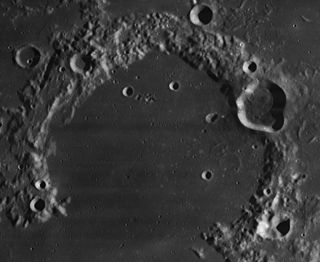
Russell is the lava-flooded remains of a lunar impact crater. It is located in the western part of the Oceanus Procellarum, close to the western lunar limb. As a result, it appears oblong-shaped due to foreshortening.

Naumann is a lunar impact crater located on the Oceanus Procellarum in the northwest sector of the Moon. It is a bowl-shaped, symmetrical crater with a relatively high-albedo rim. There are no notable impact craters overlaying the rim edge or the interior. The nearest named craters are Lichtenberg to the southwest and Nielsen to the southeast. Otherwise it is located in a region of lunar mare which is devoid of significant features.
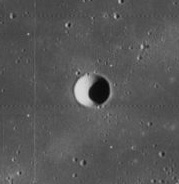
Zinner is a tiny lunar impact crater located due north of the crater Schiaparelli on the Oceanus Procellarum. It is circular and cup-shaped, with a high albedo in comparison to the surrounding lunar mare. The crater has essentially no rim because the mare lava nearly flooded it. A ray from the crater Glushko crosses Zinner. To the northwest is the slightly larger crater Golgi. East of Zinner is the Dorsa Burnet wrinkle ridge system.
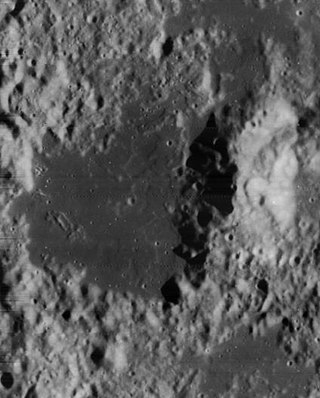
Zupus is the lava-flooded remains of a lunar impact crater. It is located on a southwestern reach of the Oceanus Procellarum, to the northwest of Mare Humorum. To the north-northeast is the flooded crater Billy, and some distance to the southeast is Mersenius. A system of faint rilles named the Rimae Zupus lie to the northwest, following a course to the north-northwest towards the mare.

Grimaldi is a large basin located near the western limb of the Moon. It lies to the southwest of the Oceanus Procellarum, and southeast of the crater Riccioli. Between Oceanus Procellarum is Damoiseau, and to the north is Lohrmann.

Herodotus is a lunar impact crater located on a low shelf in the midst of the Oceanus Procellarum. To the east is the slightly larger crater Aristarchus. West across the mare is Schiaparelli. Almost due south on the mare surface is a solitary lunar dome designated Herodotus Omega (ω).

Letronne is the lava-flooded remnant of a lunar impact crater. It was named after French archaeologist Jean-Antoine Letronne. The northern part of the rim is completely missing, and opens into the Oceanus Procellarum, forming a bay along the southwestern shore. The formation is located to the northwest of the large crater Gassendi.To the west-southwest is the flooded crater Billy, and north-northwest lies the smaller Flamsteed.

Cavalerius is a prominent lunar impact crater that lies on the western edge of the Oceanus Procellarum lunar mare on the west part of the visible Moon. It nearly joins the northern rim of Hevelius to the south.
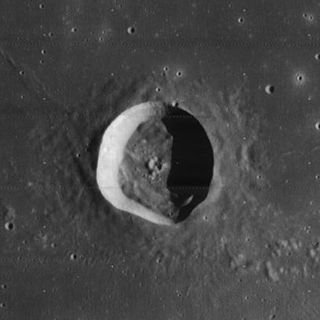
Flamsteed is a small lunar impact crater located on the Oceanus Procellarum, which is named after British astronomer John Flamsteed. It lies almost due east of the dark-hued Grimaldi, and north-northwest of the flooded Letronne bay on the south edge of the mare.

Prinz is the lava-flooded remains of a lunar impact crater on the Oceanus Procellarum. It was named after German-Belgian astronomer Wilhelm Prinz. The formation lies to the southwest of the prominent crater Aristarchus. To the north-northeast is the flooded crater Krieger.

Agatharchides is a lunar impact crater located at the southern edge of Oceanus Procellarum, in the region between the Mare Humorum and Mare Nubium. To the east-southeast is the crater Bullialdus, and to the south-southwest lies Loewy. It is named after the Greek geographer Agatharchides.

Balboa is a lunar impact crater that is located near the western limb of the Moon. Due to foreshortening, the crater appears highly oval when viewed from the Earth. In actuality, however, the formation is relatively circular. It is comparable in size to the crater Dalton, located just to the southwest. The eastern rim of Balboa lies just to the west of the Oceanus Procellarum.
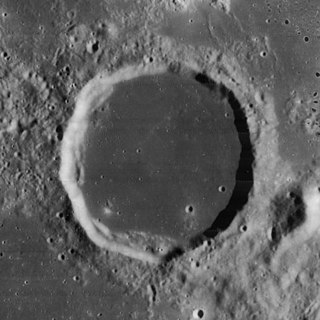
Billy is a lunar impact crater that is located at the southern fringes of the Oceanus Procellarum, in the western hemisphere of the Moon. It was named after French mathematician Jacques de Billy. It lies to the southeast of the similar-sized crater Hansteen, and west-southwest of the flooded Letronne.
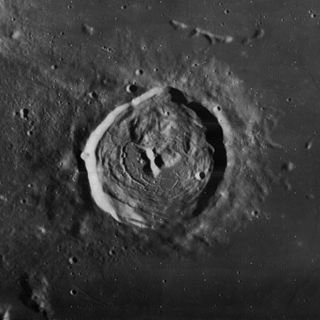
Briggs is a lunar impact crater that is located in the western part of the Oceanus Procellarum, to the east of the large walled plain Struve. It lies to the northeast of the walled plain Eddington, and north-northwest of the crater Seleucus. The isolated position of this crater on the mare, near the northwestern limb of the Moon, makes it relatively easy for an Earth-bound observer to locate. The crater is named after the English mathematician Henry Briggs.

Oenopides is a lunar impact crater that is located near the northwestern limb of the Moon, and so appears foreshortened when viewed from the Earth. This formation lies due south of the prominent crater Pythagoras, and is attached to the southwest rim of Babbage E. The southwest rim of Oenopides is part of the northern edge of Oceanus Procellarum. To the south is Markov.
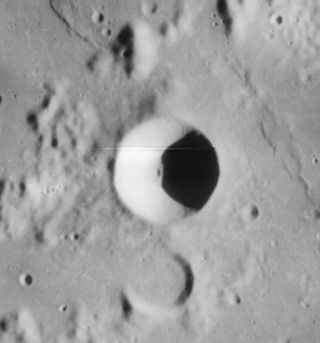
Darney is a small lunar impact crater that is located on the region of the Moon where the Mare Nubium joins the Oceanus Procellarum. It was named after French astronomer Maurice Darney. To the south is the lava-flooded crater Lubiniezky. The southern rim of Darney is attached to a series of low ridges that extend to the southwest.

Ulugh Beigh is the remnant of a lunar impact crater that is located just to the west of the Oceanus Procellarum. It is located near the northwestern limb of the Moon, and from the Earth it appears foreshortened. Farther to the west is the smaller crater Aston, and to the north is Lavoisier. Both these craters are roughly equidistant from Ulugh Beigh, although Aston appears much closer due to the oblique viewing angle.
Fontana is a lunar impact crater that is located in the southwestern part of the Moon's near side, to the south of the Oceanus Procellarum. It lies to the west-northwest of the flooded crater Zupus. Midway between Fontana and Zupus is a rille system designated Rimae Zupus.






















